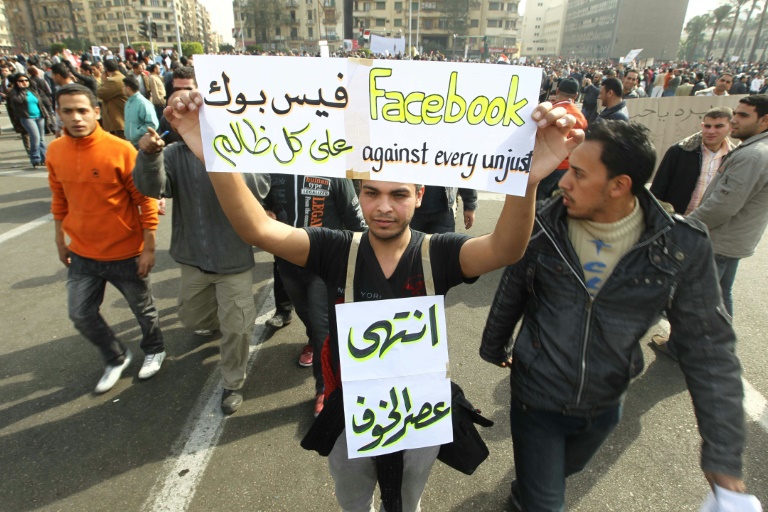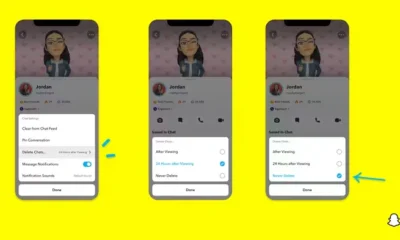SOCIAL
Cairo to Kyiv: Social media’s rocky ride through conflict zones

Facebook was hailed during the Arab Spring revolts, but its reputation was later tarnished – Copyright AFP/File KHALED DESOUKI
Joseph BOYLE with Bahira Amin in Cairo
When Yarema Dukh set up Ukraine’s official Twitter account in 2016, he knew that social media was the best way for his country to get its message out.
“We never had the means like the Russians to found multinational media like RT or Sputnik,” the former government communications adviser told AFP over the phone from Kyiv.
Since Russia’s full invasion last month, the Kyiv government has used social media to highlight atrocities, issue messages of defiance and even share a joke or two.
Young Ukrainians have used TikTok to chronicle life under Russian siege and tech enthusiasts have commandeered Telegram channels to organise donations of cryptocurrency.
On the other hand, Russia has launched an onslaught against Western tech firms and all but ended free speech online.
The Ukraine war marks the expansion of social media in conflicts from a tool of the outsider to a genuinely ubiquitous presence.
But the tortuous history of its relations with protest movements and governments — from 2011’s Arab Spring to Myanmar today — suggests Ukraine will have to fight to hold on to its gains.
– Amplifying the message –
Back in 2011, Facebook was far from the behemoth it is today and Twitter barely registered in many countries.
“We were fighting to carve out a space in the margins,” said Hossam El-Hamalawy, an Egyptian activist who became a prominent voice during the Arab Spring protests.
The revolts across the Middle East and North Africa became known as the “Facebook revolution” but the jury is still out on its overall role.
Hamalawy said social media’s real power was not as an organising tool but as a way of amplifying the message.
“I knew that anything I wrote on Twitter would get picked up (by mainstream media),” he told AFP from his home in Berlin.
In the early 2010s in Ukraine, Dukh says the most popular social media was a blogging platform called LiveJournal.
But then a journalist posted a message on his Facebook in 2014 promising to launch an anti-government rally if he received 1,000 replies.
When he got enough replies, he went to Maidan square in the heart of Kyiv and launched a protest that brought down the pro-Russian government.
The exposure also helped Facebook become the number one social network by far in Ukraine.
During this period, the US tech giant was happy to embrace its association with outsiders and protesters.
Company boss Mark Zuckerberg wrote in 2012 that the firm was not interested in profits but rather in empowering people to carry out social change.
However, social media companies were already in a much more complex position.
– ‘Extremely naive’ –
Burmese journalist Thin Lei Win said 2012 was the moment when Facebook “became the internet” in Myanmar.
“Everything was on Facebook and everybody was sharing everything,” she told AFP.
But some of the messages being shared were incendiary, spreading false information that stoked violence between Buddhist nationalists and the Muslim Rohingya minority.
By 2018, a UN rapporteur called the platform a “beast” and accused it of inciting racial hatred.
The wheels came off in Egypt too, where faction fighting among protesters on the street was mirrored by bitter feuds online.
Protest leader Wael Ghonim, whose Facebook messages had helped to galvanise the movement, told US broadcaster PBS in 2018 that he soon became a target of online disinformation.
“I was extremely naive,” he said, “thinking that these are liberating tools.”
Meanwhile in Ukraine, the Maidan revolution was also turning sour.
Moscow had used it as a pretext for annexing Crimea and sowing unrest in Ukraine’s east.
Dukh, as a new recruit in the government’s communications team, found himself battling Russian troll farms.
– Three-finger salute –
Activists in Arab Spring countries now lament how the platforms they once lauded have been retooled to serve the powerful.
A group of NGOs wrote an open letter to Facebook, Twitter and YouTube last year accusing them of supporting repression by systematically shutting accounts of dissidents across the region.
In Myanmar, a military junta seized power in a coup early last year, ending several years of liberalisation.
Dissent quickly spread across social media with the three-finger salute borrowed from the “Hunger Games” movies proving popular.
But Thin Lei Win said the authorities were aware that Burmese people were enthusiastic sharers and began stopping people in the streets and demanding to see their phones.
“If you had posted anything on your social media critical of the junta or supportive of the NUG (National Unity Government) you could be arrested,” she said.
– ‘Whack-a-mole’ –
Facebook and other platforms closed accounts of the Burmese generals shortly after the coup and, according to Thin Lei Win, established platforms have hugely improved their record with disinformation.
Thin Lei Win and activist groups point out that the generals have since hopped on to other networks and their messages still get through.
“It’s like whack-a-mole, you close something, something else pops up,” said Thin Lei Win.
Younger companies like TikTok and Telegram have been criticised for continuing to host Burmese military propaganda.
In Ukraine too, TikTok and Telegram have both been accused of failing to tackle Russian disinformation.
But Dukh, who left the Ukrainian government in 2019, continues to see the positive side of social media.
He said Ukraine had learnt lessons from its years of dealing with Russian disinformation and could share them with the world.
“We are good learners and I hope after the victory we’ll be good teachers as well,” he said.
Source link
SOCIAL
Snapchat Explores New Messaging Retention Feature: A Game-Changer or Risky Move?

In a recent announcement, Snapchat revealed a groundbreaking update that challenges its traditional design ethos. The platform is experimenting with an option that allows users to defy the 24-hour auto-delete rule, a feature synonymous with Snapchat’s ephemeral messaging model.
The proposed change aims to introduce a “Never delete” option in messaging retention settings, aligning Snapchat more closely with conventional messaging apps. While this move may blur Snapchat’s distinctive selling point, Snap appears convinced of its necessity.
According to Snap, the decision stems from user feedback and a commitment to innovation based on user needs. The company aims to provide greater flexibility and control over conversations, catering to the preferences of its community.
Currently undergoing trials in select markets, the new feature empowers users to adjust retention settings on a conversation-by-conversation basis. Flexibility remains paramount, with participants able to modify settings within chats and receive in-chat notifications to ensure transparency.
Snapchat underscores that the default auto-delete feature will persist, reinforcing its design philosophy centered on ephemerality. However, with the app gaining traction as a primary messaging platform, the option offers users a means to preserve longer chat histories.
The update marks a pivotal moment for Snapchat, renowned for its disappearing message premise, especially popular among younger demographics. Retaining this focus has been pivotal to Snapchat’s identity, but the shift suggests a broader strategy aimed at diversifying its user base.
This strategy may appeal particularly to older demographics, potentially extending Snapchat’s relevance as users age. By emulating features of conventional messaging platforms, Snapchat seeks to enhance its appeal and broaden its reach.
Yet, the introduction of message retention poses questions about Snapchat’s uniqueness. While addressing user demands, the risk of diluting Snapchat’s distinctiveness looms large.
As Snapchat ventures into uncharted territory, the outcome of this experiment remains uncertain. Will message retention propel Snapchat to new heights, or will it compromise the platform’s uniqueness?
Only time will tell.
SOCIAL
Catering to specific audience boosts your business, says accountant turned coach

While it is tempting to try to appeal to a broad audience, the founder of alcohol-free coaching service Just the Tonic, Sandra Parker, believes the best thing you can do for your business is focus on your niche. Here’s how she did just that.
When running a business, reaching out to as many clients as possible can be tempting. But it also risks making your marketing “too generic,” warns Sandra Parker, the founder of Just The Tonic Coaching.
“From the very start of my business, I knew exactly who I could help and who I couldn’t,” Parker told My Biggest Lessons.
Parker struggled with alcohol dependence as a young professional. Today, her business targets high-achieving individuals who face challenges similar to those she had early in her career.
“I understand their frustrations, I understand their fears, and I understand their coping mechanisms and the stories they’re telling themselves,” Parker said. “Because of that, I’m able to market very effectively, to speak in a language that they understand, and am able to reach them.”Â
“I believe that it’s really important that you know exactly who your customer or your client is, and you target them, and you resist the temptation to make your marketing too generic to try and reach everyone,” she explained.
“If you speak specifically to your target clients, you will reach them, and I believe that’s the way that you’re going to be more successful.
Watch the video for more of Sandra Parker’s biggest lessons.
SOCIAL
Instagram Tests Live-Stream Games to Enhance Engagement

Instagram’s testing out some new options to help spice up your live-streams in the app, with some live broadcasters now able to select a game that they can play with viewers in-stream.
As you can see in these example screens, posted by Ahmed Ghanem, some creators now have the option to play either “This or That”, a question and answer prompt that you can share with your viewers, or “Trivia”, to generate more engagement within your IG live-streams.
That could be a simple way to spark more conversation and interaction, which could then lead into further engagement opportunities from your live audience.
Meta’s been exploring more ways to make live-streaming a bigger consideration for IG creators, with a view to live-streams potentially catching on with more users.
That includes the gradual expansion of its “Stars” live-stream donation program, giving more creators in more regions a means to accept donations from live-stream viewers, while back in December, Instagram also added some new options to make it easier to go live using third-party tools via desktop PCs.
Live streaming has been a major shift in China, where shopping live-streams, in particular, have led to massive opportunities for streaming platforms. They haven’t caught on in the same way in Western regions, but as TikTok and YouTube look to push live-stream adoption, there is still a chance that they will become a much bigger element in future.
Which is why IG is also trying to stay in touch, and add more ways for its creators to engage via streams. Live-stream games is another element within this, which could make this a better community-building, and potentially sales-driving option.
We’ve asked Instagram for more information on this test, and we’ll update this post if/when we hear back.
-

 PPC6 days ago
PPC6 days ago19 Best SEO Tools in 2024 (For Every Use Case)
-

 MARKETING7 days ago
MARKETING7 days agoEcommerce evolution: Blurring the lines between B2B and B2C
-
SEARCHENGINES5 days ago
Daily Search Forum Recap: April 19, 2024
-
SEARCHENGINES6 days ago
Daily Search Forum Recap: April 18, 2024
-

 WORDPRESS6 days ago
WORDPRESS6 days agoHow to Make $5000 of Passive Income Every Month in WordPress
-

 SEO7 days ago
SEO7 days ago2024 WordPress Vulnerability Report Shows Errors Sites Keep Making
-

 WORDPRESS6 days ago
WORDPRESS6 days ago10 Amazing WordPress Design Resouces – WordPress.com News
-

 SEO6 days ago
SEO6 days ago25 WordPress Alternatives Best For SEO
















You must be logged in to post a comment Login